Page 95 of 340
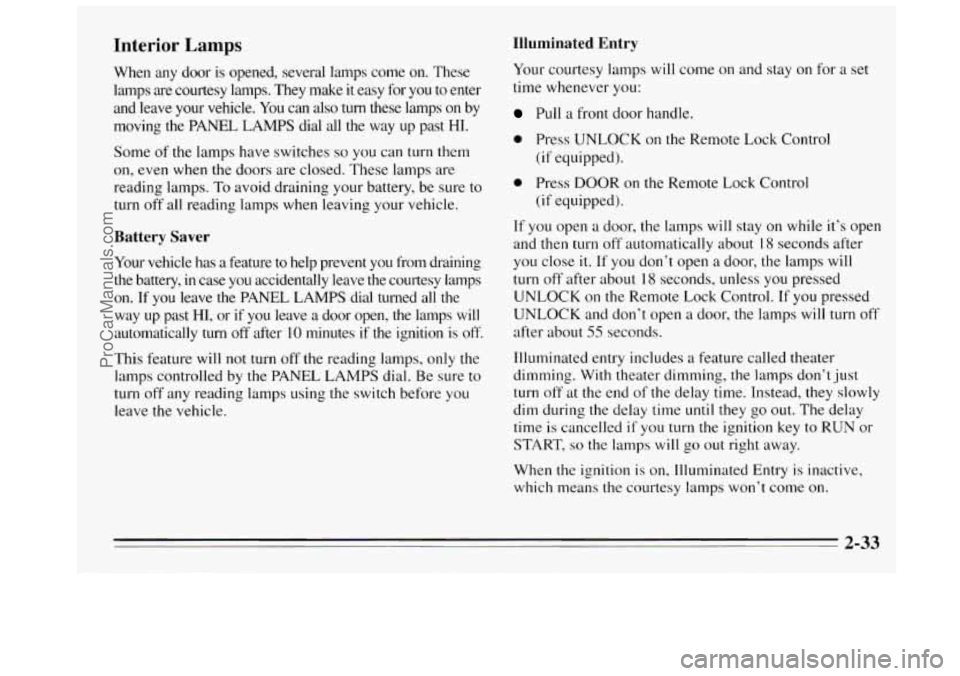
Interior Lamps
When any door is opened, several lamps come on. These
lamps
are courtesy lamps. They make it easy for you to enter
and leave your
vehcle. You can also turn these lamps on by
moving the PANEL LAMPS dial all the way up past
HI.
Some of the lamps have switches so you can turn them
on, even when the doors are closed. These lamps are
reading lamps.
To avoid draining your battery, be sure to
turn
off all reading lamps when leaving your vehicle.
Illuminated Entry
Battery Saver
Your vehicle has a feature to help prevent you from draining
the battery, in case you accidentally leave the courtesy lamps
on. If you leave the PANEL LAMPS dial turned all the
way up past
HI, or if you leave a door open, the lamps will
automatically
turn off after 10 minutes if the ignition is off.
This feature will not turn off the reading lamps, only the
lamps controlled by
the PANEL LAMPS dial. Be sure to
turn off any reading lamps using the switch before you
leave the vehicle. Your
courtesy lamps will come on and stay on for
a set
time whenever you:
Pull a front door handle.
0 Press UNLOCK on the Remote Lock Control
(if equipped).
0 Press DOOR on the Remote Lock Control
(if equipped).
If you open
a door, the lamps will stay on while it’s open
and then turn off automatically about 18 seconds after
you close it. If you don’t open a door,
the lamps will
turn off after about 18 seconds, unless you pressed
UNLOCK
on the Remote Lock Control. If you pressed
UNLOCK and don’t open
a door, the lamps will turn off
after about 55 seconds.
Illuminated entry includes a feature called theater
dimming. With theater dimming,
the lamps don’t just
turn off at the end of the delay time. Instead, they slowly
dim during the delay time
until they go out. The delay
time
is cancelled if you turn the ignition key to RUN or
START,
so the lamps will go out right away.
When the ignition is on, Illuminated Entry is inactive,
which means the courtesy lamps won’t come on.
ProCarManuals.com
Page 108 of 340
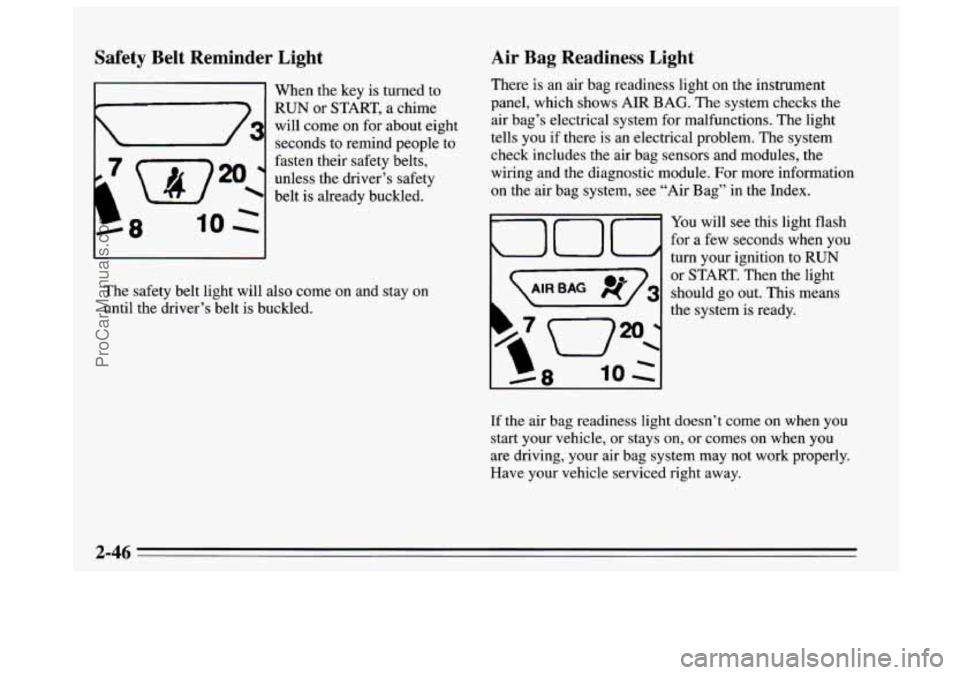
Safety Belt Reminder Light
b3
8
When the key is turned to
RUN or START, a chime
will come
on for about eight
seconds to remind people to
fasten their safety belts,
unless the driver’s safety belt
is already buckled.
The safety belt light will also come on and stay
on
until the driver’s belt is buckled.
Air Bag Readiness Light
There is an air bag readiness light on the instrument
panel, which shows AIR BAG. The system checks the
air bag’s electrical system for malfunctions. The light
tells
you if there is an electrical problem. The system
check includes the air bag sensors and modules, the
wiring and the diagnostic module. For more information
on the air bag system, see “Air Bag” in the Index.
10: I
You will see this light flash
for a few seconds when you
turn your ignition to RUN
or START. Then the light
AIR BAG 4 3 should go out. This means
the system is ready.
-8 10 :
If the air bag readiness light doesn’t come on when you
start your vehicle, or stays on, or comes on when you
are driving, your air bag system may not work properly.
Have your vehicle serviced right away.
2-46
ProCarManuals.com
Page 114 of 340

Sometimes when the engine is idling at a stop, the
0 If you make a hard stop, the light may come on for a
light
may blink
011 and off. This is normal.
moment. This is normal.
1 NOTICE:
Damage to your engine from neglected oil
problems can be costly and
is not covered by your
warranty.
Low Oil Level Light
Your engine is equipped
with an oil level monitoring
system. When the ignition
key
is turned on, the LOW
OIL LEVEL light will
briefly flash. If the light
does not flash, have it fixed
so it will be ready to warn
you
if there’s a problem.
If the light stays on, stop the vehicle on a level surface
and turn
the engine off. Check the oil level using the
engine oil dipstick. (See “Engine Oil” in the Index.) If
the light does not flash, have the low oil level sensor
system repaired
so it will be ready to warn you if there’s
a problem.
The oil level monitoring system only checks oil level
during
the brief period between key on and engine
crank. It does not monitor engine oil level when the
engine is running. Additionally, an oil level check is
only performed if the engine has been turned off for a
considerable period of time, allowing the oil normally in
circulation
to drain back into the oil pan.
ProCarManuals.com
Page 115 of 340
Security Light
' This light will come on
when you turn the
key to
start and stay on until the
vehicle starts.
It will also
come on and stay
on if your
key is too dirty or wet for
the PASS-Key@% system to
read the resistor pellet.
If the resistor pellet is damaged or missing, the light will
flash.
If you're driving and the security light comes on and
remains on, your PASS-Key@II system is not working
properly. Your vehicle
is not protected by
PASS-Key%,
and you should see your dealer.
Cruise Light
The CRUISE light comes
on whenever
you set your
cruise control.
2-53
ProCarManuals.com
Page 140 of 340
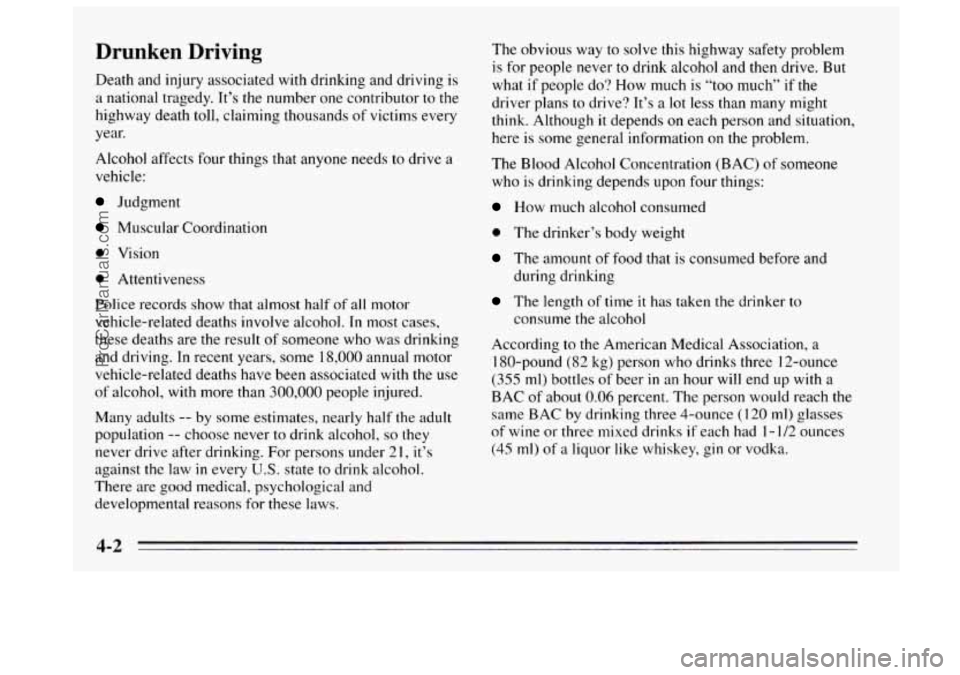
Drunken Driving
Death and injury associated with drinking and driving is
a national tragedy. It’s the number one contributor to the
highway death toll, claiming thousands of victims every
year.
Alcohol affects four things that anyone needs
to drive a
vehicle:
Judgment
Muscular Coordination
0 Vision
0 Attentiveness
Police records show that almost half
of all motor
vehicle-related deaths involve alcohol. In most cases,
these deaths are the result of someone who was drinking
and driving. In recent years, some 18,000 annual motor
vehicle-related deaths have been associated with the use
of alcohol, with more than
300,000 people injured.
Many adults
-- by some estimates, nearly half the adult
population
-- choose never to drink alcohol, so they
never drive after drinking. For persons under 2
1 , it’s
against the law in every U.S. state to drink alcohol.
There are good medical, psychological and
developmental reasons for these laws. The obvious
way to solve this highway safety problem
is for people never to drink alcohol and then drive. But
what
if people do? How much is “too much’’ if the
driver plans to drive? It’s a lot less than many might
think. Although
it depends on each person and situation,
here is some general information on the problem.
The Blood Alcohol Concentration (BAC) of someone
who is drinking depends upon four things:
How much alcohol consumed
0 The drinker’s body weight
The amount of food that is consumed before and
during drinking
The length of time it has taken the drinker to
consume
the alcohol
According to the American Medical Association, a
180-pound
(82 kg) person who drinks three 12-ounce
(355 ml) bottles of beer in an hour will end up with a
BAC of about
0.06 percent. The person would reach the
same BAC by drinking three 4-ounce
(1 20 ml) glasses
of wine or three mixed drinks
if each had 1-1/2 ounces
(45 ml) of a liquor like whiskey, gin or vodka.
4-2
ProCarManuals.com
Page 183 of 340
When your vehicle is being towed, have the ignition key
off. The steering wheel should be clamped in a
straight-ahead position, with
a clamping device
designed for towing service.
Do not use the vehicle’s
steering column lock for this. The transaxle should be
in
NEUTRAL (N) and the parking brake released.
Don’t have your vehicle towed on the front wheels,
unless
you must. If the vehicle must be towed on the
front wheels, don’t go more than
35 mph (56 km/h) or
farther than
50 miles (80 km) or your transaxle will be
damaged.
If these limits must be exceeded, then the
front wheels have to be supported
on a dolly.
A CAUTION:
5-9
ProCarManuals.com
Page 305 of 340
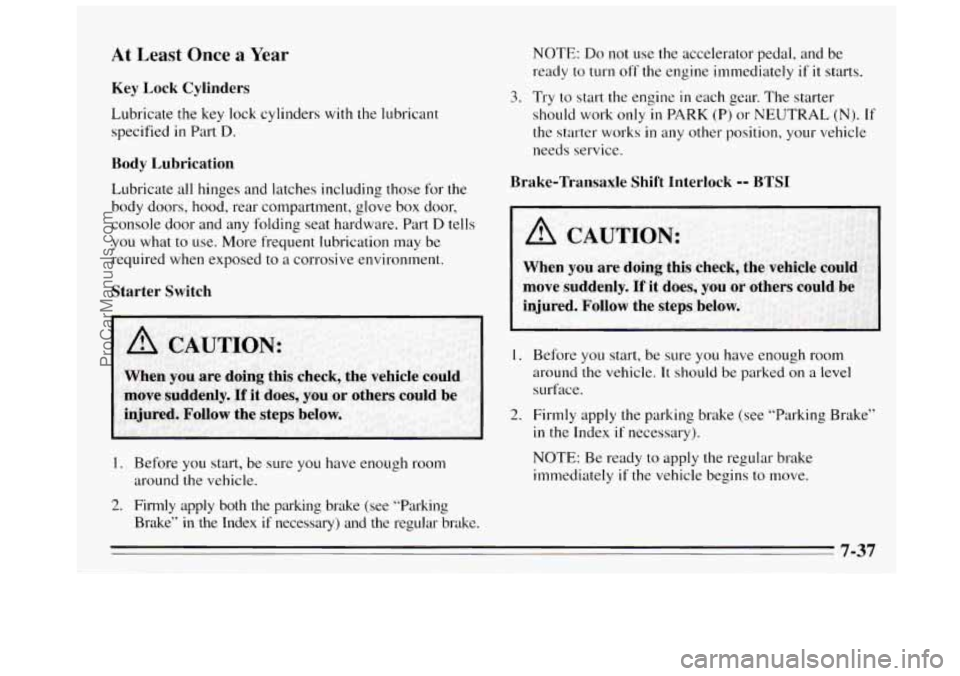
At Least Once a Year
Key Lock Cylinders
Lubricate the key lock cylinders with the lubricant
specified
in Part D.
Body Lubrication
Lubricate all hinges and latches including those for the
body doors, hood, rear compartment, glove
box door,
console door and any folding seat hardware. Part
D tells
you what to use. More frequent lubrication may be
required when exposed to a corrosive environment.
Starter Switch
I I
When you are doing this check, the vehicle could
move suddenly. If it does, you or others could be
injured. Follow
the steps below.
1. Before you start, be sure you have enough room
around the vehicle.
2. Firmly apply both the parking brake (see “Parking
Brake”
in the Index if necessary) and the regular brake.
NOTE: Do not use the accelerator pedal, and be
ready
to turn off the engine immediately if it starts.
3. Try to start the engine in each gear. The starter
should work only
in PARK (P) or NEUTRAL (N). If
the starter works in any other position, your vehicle
needs service.
Brake-Transaxle Shift Interlock -- BTSI
I I
1. Before you start, be sure you have enough room
around the vehicle. It should
be parked on a level
surface.
2. Firmly apply the parking brake (see “Parking Brake”
in the Index
if necessary).
NOTE: Be ready to apply the regular brake
immediately
if the vehicle begins to move.
7-37
ProCarManuals.com
Page 306 of 340
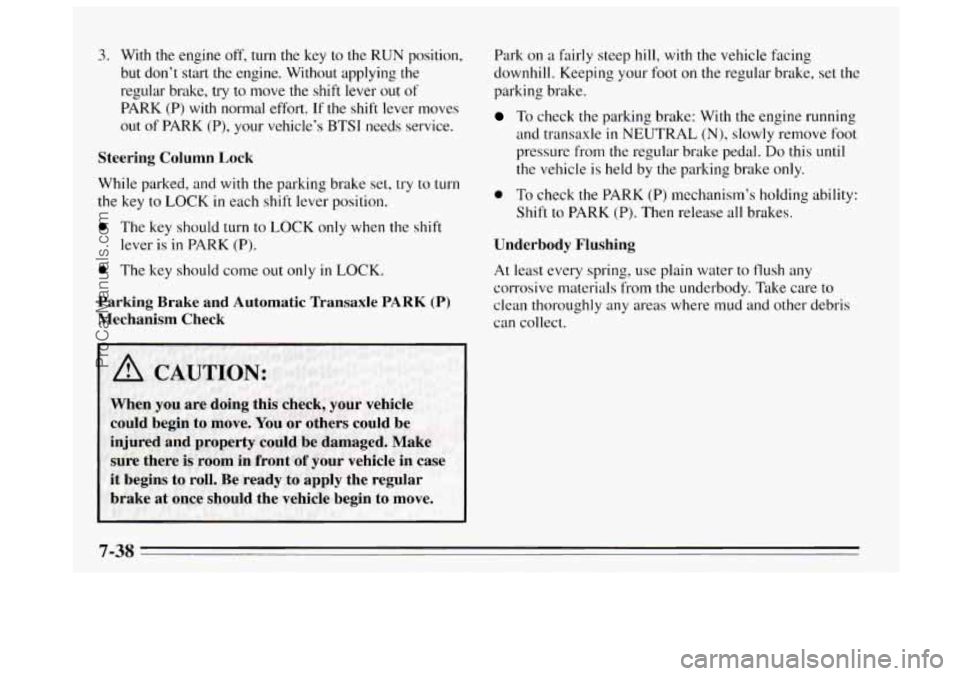
3. With the engine off, turn the key to the RUN position,
but don’t start the engine. Without applying the
regular brake, try to move the shift lever out of
PARK (P) with normal effort. If the shift lever moves
out
of PARK (P), your vehicle’s BTSI needs service.
Steering Column Lock
While parked, and with the parking brake set, try to turn
the key to LOCK in each shift lever position.
0 The key should turn to LOCK only when the shift
lever is
in PARK (P).
0 The key should come out only in LOCK.
Parking Brake and Automatic Transaxle PARK (P)
Mechanism Check
Park on a fairly steep hill, with the vehicle facing
downhill. Keeping your foot on the regular brake, set the
parking brake.
To check the parking brake: With the engine running
and transaxle
in NEUTRAL (N), slowly remove foot
pressure from the regular brake pedal.
Do this until
the vehicle
is held by the parking brake only.
0 To check the PARK (P) mechanism’s holding ability:
Shift to PARK (P). Then release
all brakes.
Underbody Flushing
At least every spring, use plain water to flush any
corrosive materials from the underbody. Take care to
clean thoroughly any areas where mud and other debris
can collect.
7-38
ProCarManuals.com